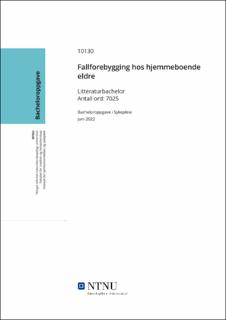| dc.contributor.advisor | Nakrem, Sigrid | |
| dc.contributor.author | Tøndel, Emilie | |
| dc.date.accessioned | 2022-09-15T17:19:18Z | |
| dc.date.available | 2022-09-15T17:19:18Z | |
| dc.date.issued | 2022 | |
| dc.identifier | no.ntnu:inspera:110921428:51173771 | |
| dc.identifier.uri | https://hdl.handle.net/11250/3018214 | |
| dc.description.abstract | Tittel: Fallforebygging hos hjemmeboende eldre
Bakgrunn: Fall er en av de viktigste årsakene til dødsfall og helsetap blant eldre i norge. Fall og fallskader er også en belastning for den som faller, helsetjenesten og samfunnsøkonomien. Det er sjeldent kun en årsak til at eldre faller, da det ofte er et samspill mellom flere faktorer. Å forebygge fall og vurdere fallrisiko er derfor svært viktig, men også komplisert for både helsepersonell og de eldre. Sykepleier må derfor kjenne til hvilke faktorer som kan øke fallrisikoen, samt hvordan man kan forebygge fall.
Hensikt: Å undersøke hvordan sykepleier kan forebygge fall hos hjemmeboende eldre ved kartlegging, risikovurdering, trening og teknologiske løsninger gjennom følgende problemstilling; Hvordan kan sykepleier bidra til å forebygge fall hos hjemmeboende eldre?
Metode: En litteraturstudie som er basert på ni utvalgte forskningsartikler. Kunnskap er supplementert med pensumlitteratur fra sykepleiestudiet og andre relevante fagbøker.
Resultat: Det er enighet i studiene om at trening er et godt tiltak for å opprettholde ADL-funksjon, balanse og styrke. Det er ikke enighet blandt studiene rundt den fallforebyggende effekten. Ingen kartleggingsverktøy alene vil med høy sikkerhet kunne si noe om risiko for fall. Det finnes og utvikles stadig flere nye teknologiske løsninger som berører de eldres hverdag.
Konklusjon: Sykepleier kan ikke nødvendigvis forebygge at eldre faller, men kan bidra til å redusere risikoen og minske konsekvensene av fall. Dette gjennom kartlegging, risikovurdering, trening av styrke og balanse, samt teknologiske løsninger.
Nøkkelord: Fall, eldre, kartlegging, trening, teknologi | |
| dc.description.abstract | Tittle: Fall prevention in community-dwelling elderly people.
Background: Fall is one of the most important causes of death and loss of health among elderly people in Norway. Fall and fall injuries are also a burden for those who fall, the health service and the society economy. There is rarely only one reason why the elderly fall, as there is often an interplay between several factors. Preventing falls and assessing fall risks is very important, but also complicated both for health professionals and the elderly. The nurse must therefore know which factors can increase the risk of falling, as well as how to prevent falls.
Aim: The aim of this study is to investigate how nurses can prevent falls among the community-dwelling elderly through screening, risk assessment, exercise and technological solutions through the following problem; How can nurses prevent falls in elderly people living at home?
Methods: A literature study based on nine selected articles. Knowledge is supplemented with curriculum books from the nursing study and other relevant books.
Results: Several of the studies agree that exercise is a good measure to maintain ADL-function, balance and strength. There is no consensus among the studies on the fall prevention effect. There is no screening tool alone that with high certainty can predict the risk of falling. New technology that affects the elderly’s everyday life exists and continues to develop.
Conclusion: A nurse can not necessarily prevent the elderly from falling. They can help by reducing the fall risk and the consequences of falling. This thorough screening, risk assessment, strength- and balance exercises, as well as technological solutions.
Key words: Fall, Elderly, Screening, Exercise, Technology | |
| dc.language | nob | |
| dc.publisher | NTNU | |
| dc.title | Fallforebygging hos hjemmeboende eldre | |
| dc.type | Bachelor thesis | |
